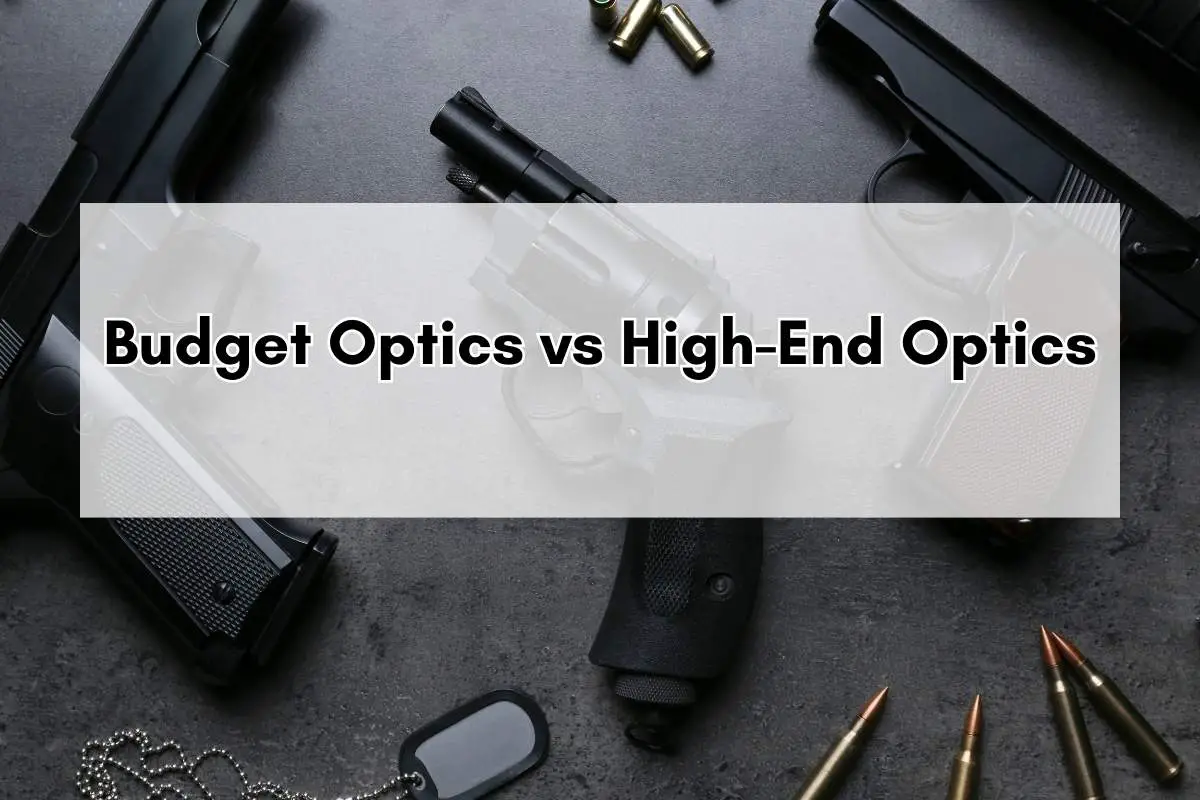Choosing between budget and high-end optics can be tricky for hunters and shooters. Many wonder if pricier scopes are worth the extra cost. The truth is, both options have their place.
The main difference between budget and high-end optics is usually quality of materials, durability, and clarity of image. Expensive scopes often provide better clarity and durability. But that doesn’t mean all budget scopes are bad. Some affordable options can work well for many shooters.
Your needs and budget should guide your choice. A casual shooter might be happy with a less expensive scope. Someone who hunts in tough conditions might want to invest in a pricier, more rugged option. It’s about finding the right balance for your situation.
Key Takeaways
- Quality of materials, durability, and image clarity often justify higher prices for optics
- Budget optics can work well for many shooters, depending on their needs
- Matching the optic to your specific use and conditions is key for satisfaction
Understanding Optics: Basics and Terminology
Optics are an essential part of rifle scopes. They help shooters see targets more clearly at various distances. Riflescopes have several key components that work together to improve vision and accuracy.
The main parts of a riflescope include:
- Objective lens
- Ocular lens
- Erector system
- Reticle
Magnification is an important feature of scopes. It determines how much closer a target appears. For example, a 3-9x scope can make objects look 3 to 9 times closer.
Light transmission is another crucial factor. It refers to how much light passes through the scope. Higher-end scopes often have better light transmission, up to 95%.
Coatings on lenses help reduce glare and improve image clarity. Multi-coated lenses are common in quality scopes.
Field of view is the area visible through the scope. It usually decreases as magnification increases.
Eye relief is the distance between the eye and ocular lens where the full image is visible. Longer eye relief can be more comfortable and safer, especially for high-recoil rifles.
Understanding these terms helps shooters choose the right scope for their needs. It also allows for better use of the equipment in various shooting situations.
Comparing Price Points: Budget vs. Premium
Rifle scope prices vary widely, from under $100 to over $2,500. This price range reflects key differences in quality, features, and performance that impact a shooter’s experience.
Material Quality and Durability
Budget scopes often use lower-grade materials to keep costs down. They may have aluminum bodies and basic coatings. These scopes can work for casual use but may not hold up to heavy recoil or harsh conditions.
High-end scopes use premium materials like aircraft-grade aluminum or titanium. They have tougher coatings and seals to resist water, fog, and impacts. This makes them more reliable in extreme weather and rugged terrain.
Premium scopes typically last much longer. Many can withstand a decade or more of regular use. Budget optics may need replacement after just a few years.
Clarity and Precision of Lenses
Lens quality greatly impacts image clarity and light transmission. Budget scopes use simpler glass and coatings. This can result in less sharp images, especially in low light.
High-end optics use advanced glass like ED (extra-low dispersion) or fluorite crystal. These reduce color fringing and increase contrast. Multi-layer coatings improve light transmission and reduce glare.
Premium scopes offer better eye relief and a wider field of view. This improves target acquisition and reduces eye strain during long shooting sessions.
Features and Technological Innovations
Budget scopes often have basic features like fixed magnification or simple reticles. Adjustments may be less precise and have a limited range.
Premium optics include advanced features such as:
- Illuminated reticles
- Zero-stop turrets
- Wide magnification ranges
- Parallax adjustment
- First focal plane reticles
These features enhance accuracy and versatility for different shooting scenarios. High-end scopes also tend to have more precise and repeatable adjustments.
Brand Reputation and Warranty
Well-known brands invest heavily in research, quality control, and customer support. This often translates to better overall performance and reliability.
Budget brands may offer limited warranties, typically 1-2 years. Premium optics makers often provide lifetime warranties. This shows confidence in their products and provides long-term value.
High-end scope makers also tend to have better customer service. They may offer repair services, replacement parts, and expert advice to support their products long-term.
Performance on the Field: User Experiences
Real-world use reveals key differences between budget and high-end optics. Users report varied experiences across hunting, competitive shooting, and recreational activities.
Hunting and Shooting Scenarios
Hunters often find high-end optics offer superior clarity in low-light conditions. This proves crucial during dawn and dusk, when game is most active.
Budget optics can perform adequately in good lighting. But they may struggle in dim environments or at longer ranges. Some users report difficulty acquiring targets quickly with cheaper scopes.
High-end scopes typically provide better eye relief. This reduces eye strain during extended use. It also helps prevent scope bite when shooting powerful calibers.
Durability is another factor. Premium optics tend to withstand harsh field conditions better. They resist fogging, water damage, and impacts more effectively than budget alternatives.
Competitive Shooting
In competitive settings, precision is paramount. High-end optics often feature advanced reticles and turret systems. These allow for quick and accurate adjustments.
Budget scopes may have simpler reticles and less precise adjustments. This can hinder performance in timed events or long-range competitions.
Clarity becomes crucial in distinguishing targets at varying distances. Premium glass provides sharper images and better contrast. This helps shooters identify and engage targets faster.
Some budget options offer decent performance for casual competitions. But serious competitors often find the investment in high-end optics pays off in improved scores.
Recreational Use
For casual shooting or plinking, budget optics often suffice. Many users find them adequate for short to medium-range target practice.
Birdwatchers and nature enthusiasts may prefer mid-range or high-end optics. These provide better color fidelity and clarity, enhancing the viewing experience.
Weight can be a factor for recreational users. Budget optics are sometimes heavier, which may cause fatigue during extended use.
Ease of use varies. Some high-end optics offer user-friendly features like quick-focus eyepieces. Budget options might require more manual adjustments.
Buying Guide: Making an Informed Decision
Choosing the right optics requires careful thought about your specific needs and financial considerations. These factors will help guide you to the best choice for your situation.
Identifying Your Needs and Preferences
Think about how you’ll use your optics. For hunting, consider the typical distances and lighting conditions you’ll encounter. Birdwatchers might need different features than stargazers.
Look at magnification levels. Higher isn’t always better – it depends on your activity. Optics quality affects clarity and brightness, especially in low light.
Check the size and weight. Will you carry them long distances? Compact models may be preferable for backpacking or travel.
Durability matters too. Rugged terrain demands tougher construction. Look for waterproof and fog-proof options if you’ll be in challenging weather.
Considering Your Budget
Set a realistic budget range. Remember, quality optics can be a long-term investment.
Compare features across price points. Sometimes spending a bit more can get you significantly better performance.
Look for sales or package deals. Many retailers offer discounts on optics, especially during hunting seasons.
Consider mid-range options. These often provide a good balance of quality and affordability.
Don’t forget about warranties and customer service. A solid warranty can protect your investment and provide peace of mind.
Potential Pitfalls: Avoiding Common Mistakes
When choosing optics, both budget and high-end options can lead to mistakes. Being aware of these pitfalls helps shooters make better decisions.
One common error is picking the wrong type of scope for the intended use. A scope that works well in open fields may not be suitable for dense areas.
Improper mounting is another frequent issue. Even expensive scopes won’t perform well if not mounted correctly. Loose mounts can affect accuracy and damage the optic.
Buyers often focus solely on magnification, neglecting other important features. Higher magnification isn’t always better, especially for close-range shooting.
Neglecting eye relief can lead to discomfort or injury. This is especially crucial for high-recoil firearms.
Some shooters overlook the importance of quality glass. Clear, sharp images are vital for long-range accuracy.
Choosing based on price alone is risky. The cheapest option may not meet needs, while the most expensive isn’t always necessary.
Failing to consider durability can be costly. Optics should withstand the intended environment and usage.
By avoiding these common mistakes, shooters can select optics that enhance their performance without unnecessary expense.
Frequently Asked Questions
Optics selection impacts shooting performance, budget considerations, and specific use cases. Brand choice and key features play crucial roles in the overall experience.
What are the comparative advantages of high-end optics over budget optics?
High-end optics often provide better image clarity and light transmission. They typically offer more durable construction and can withstand harsh conditions.
Advanced coatings on premium lenses reduce glare and improve contrast. High-end scopes usually have more precise adjustments and hold zero better over time.
Can budget optics perform well for hunting purposes?
Budget optics can be suitable for hunting, especially in close to medium range situations. Many hunters use affordable scopes successfully for common game animals.
Some budget options offer good value and perform well in normal hunting conditions. They may lack some features of high-end optics but can still be effective for many hunters.
What features should one look for when choosing between a red dot and a traditional scope?
Red dots excel in close-quarters and fast target acquisition scenarios. They offer unlimited eye relief and both-eyes-open shooting.
Traditional scopes provide magnification for long-range precision. They typically have adjustable parallax and more complex reticle options for range estimation and holdovers.
How does the choice of optic brand affect the shooting experience?
Reputable brands often provide better quality control and customer service. Their products tend to have more consistent performance across units.
Some brands specialize in certain types of optics or shooting disciplines. This expertise can translate into features tailored for specific uses.
What factors justify the price difference between cheap and expensive scopes?
Expensive scopes often use higher quality glass and coatings. They may offer more precise and repeatable adjustments.
Premium scopes usually undergo more rigorous testing. They often come with better warranties and after-sales support.
What brands of optics are commonly used by the military?
Military optics often come from brands like Trijicon, Aimpoint, and EOTech. These companies produce rugged, battle-tested sights and scopes.
Leupold and Nightforce are also popular for precision rifle applications. Military optics prioritize durability, reliability, and performance under extreme conditions.

